Giulio Romano
Paintings
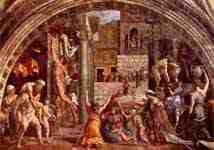
Stanza dell'Incendio di Borgo: Borgo fire
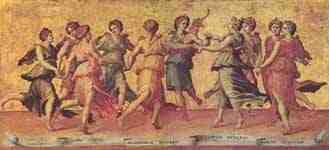
Dance of Apollo with the Muses
Drawings
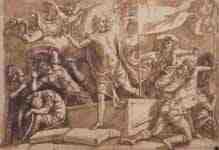
Resurrection of Christ
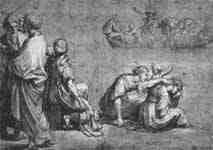
Peter's call
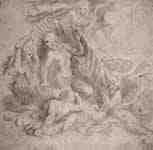
The Birth of Venus
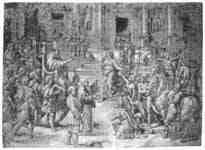
The Donation of Constantine
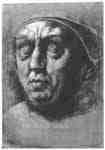
Portrait of Leo X
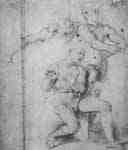
Study on "Transfiguration"
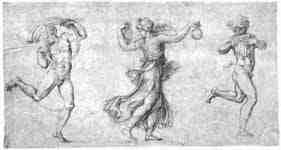
Dancing Bacchante between fauns
Giulio Romano (c. 1499 – 1 November 1546) was an Italian painter and architect. A pupil of Raphael, his stylistic deviations from high Renaissance classicism help define the 16th-century style known as Mannerism. Giulio's drawings have long been treasured by collectors; contemporary prints of them engraved by Marcantonio Raimondi were a significant contribution to the spread of 16th-century Italian style throughout Europe.
Biography
The Wedding Feast of Cupid and Psyche, fresco in Palazzo del Te, Mantua.
Giulio Romano was born in Rome.
In his native city, as a young assistant in Raphael's studio, he worked on the frescos in the Vatican loggias to designs by Raphael and in Raphael's Stanze in the Vatican painted a group of figures in the Fire in the Borgo fresco. He also collaborated on the decoration of the ceiling of the Villa Farnesina. After the death of Raphael in 1520, he helped complete the Vatican frescoes of the life of Constantine as well as Raphael's Coronation of the Virgin and the Transfiguration in the Vatican. In Rome, Giulio decorated the Villa Madama for Cardinal Giuliano de' Medici, afterwards Clement VII. The crowded Giulio Romano frescoes lack the stately and serene simplicity of his master.
In the Palazzo Te, Mantua.
After the Sack of Rome in 1527 and the death of Leo X, artistic patronage in Rome slackened. Vasari tells how Baldassare Castiglione was delegated by Federico Gonzaga to procure Giulio to execute paintings and architectural and engineering projects for the duchy of Mantua. His masterpiece of architecture and fresco painting in that city is the suburban Palazzo Te, with its famous illusionistic frescos (c. 1525–1535). He also helped rebuild the ducal palace in Mantua, reconstructed the cathedral, and designed the nearby Church of San Benedetto. Sections of Mantua that had been flood-prone were refurbished under Giulio's direction, and the duke's patronage and friendship never faltered: Giulio's annual income amounted to more than 1000 ducats. His studio became a popular school of art.
In Renaissance tradition, many works of Giulio's were only temporary. According to Giorgio Vasari:
When Charles V came to Mantua, Giulio, by the duke's order, made many fine arches, scenes for comedies and other things, in which he had no peer, no one being like him for masquerades, and making curious costumes for jousts, feasts, tournaments, which excited great wonder in the emperor and in all present. For the city of Mantua at various times he designed temples, chapels, houses, gardens, facades, and was so fond of decorating them that, by his industry, he rendered dry, healthy and pleasant places previously miry, full of stagnant water,and almost uninhabitable.[1]
He traveled to France in the first half of the 16th century and brought concepts of the Italian style to the French court of Francis I.
Giulio also designed tapestries and the erotic album I Modi which was expertly engraved by Marcantonio Raimondi, a project that landed Raimondi in jail in Rome.
In 1546, just as he was appointed architect to St. Peter's, Giulio Romano died.
Giulio Romano has the distinction of being the only Renaissance artist to be mentioned by William Shakespeare. In Act V, Scene II of The Winter's Tale Queen Hermione's statue is by "that rare Italian master, Julio Romano", although Giulio was not a sculptor.
Selected paintings and drawings
Madonna & Child, c. 1523
* The Stoning of St. Stephen (Santo Stefano, Genoa): "Giulio never did a finer work than this," said Vasari. Domenico del Barbiere engraved the subject, so that it influenced designers who never saw the original in Genoa.
* Adoration of the Magi (Louvre).
* Fire in the Borgo, fresco (Raphael Rooms in Vatican City).
* Emblematic Figures, pen and brown ink and wash over graphite (Fine Arts Museum of San Francisco).
* The Battle of the Milvian Bridge
* The Triumph of Titus and Vespasian
References
1. ^ Vasari, Vite
* Vita[1] by Giorgio Vasari, who describes his meeting with Giulio:
" At this time Giorgio Vasari a great friend of Giulio, though they only knew each other by report and by letters, passed through Mantua on his way to Venice to see him and his works. On meeting, they recognised each other as though they had met a thousand times before. Giulio was so delighted that he spent four days in showing Vasari all his works, especially the plans of ancient buildings at Rome, Naples, Pozzuolo, Campagna, and all the other principal antiquities designed partly by him and partly by others. Then, opening a great cupboard, he showed him plans of all the buildings erected from his designs in Mantua, Rome and all Lombardy, so beautiful that I do not believe that more original, fanciful or convenient buildings exist."
Retrieved from "http://en.wikipedia.org/ ", Text is available under the Creative Commons Attribution-ShareAlike License
